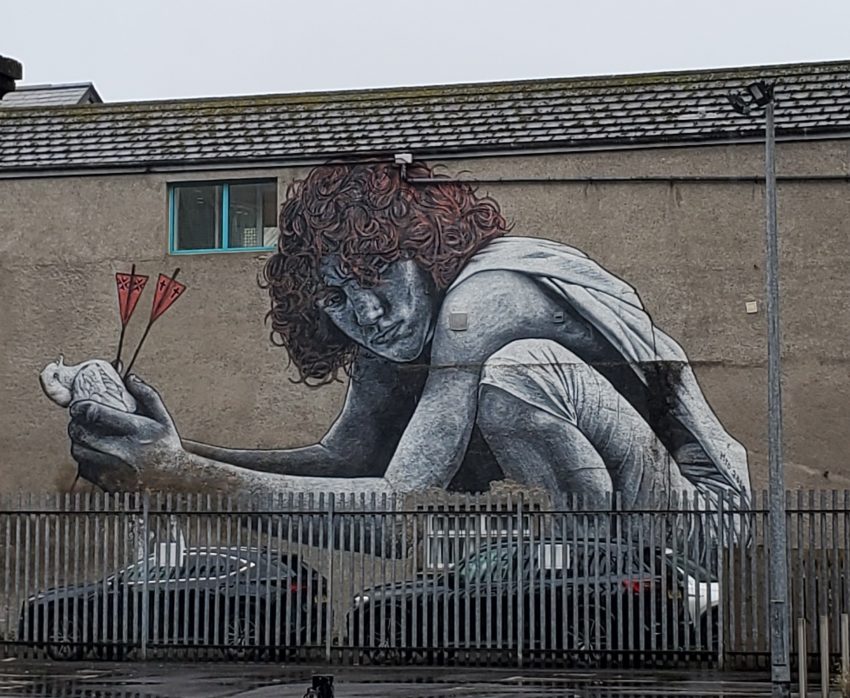During our port stop in Belfast we wanted to find a meaningful way to explore the city. We considered and dismissed the breath taking nature of Giant’s Causeway and the well known history of the Titanic Museum, both of which we will see when we return. Instead we chose to do a walking tour that explored the urban art of this city’s turbulent past.
dismissed the breath taking nature of Giant’s Causeway and the well known history of the Titanic Museum, both of which we will see when we return. Instead we chose to do a walking tour that explored the urban art of this city’s turbulent past.
We found a tour that fit our needs on Viator (https://www.viator.com/tours/Belfast/Belfast-Political-Murals-Street-Art-and-Peace-Gate/d738-61371P4). There were three of us plus our excellent guide. It was a cold and rainy afternoon that somehow made us all feel the gravity of the events of the past.

We started at the Catholic Cathedral where our guide filled us in on the history of the city leading up the The Troubles that started in the later part of the last century and still influence the city today. As we walked around the residential areas of the city to view the art, some modern and others from decades past, he used that period of time to explain the evolution of Belfast’s more recent history.
The Troubles is the term used to describe the violent conflict in Northern Ireland between the Protestant unionists (loyalists), who desired the province to remain part of the U.K., and the Roman Catholic nationalists (republicans), who wanted Northern Ireland to become part of Ireland. It occurred from about 1968 to 1998.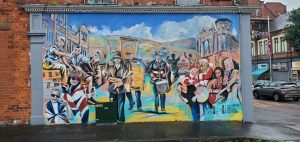
When Ireland attained independence through armed revolution in 1922, Britain and the leaders of the Irish independence movement negotiated a treaty that kept Ulster a part of the United Kingdom as Northern Ireland.
While there had been previous protests and riots in 1960s Northern Ireland, the 1969 Riots were by far the most damaging. They ended in 8 people dead, 750 injured, and over 150 homes destroyed, with Irish-Catholics suffering the majority of the losses. Both sides of the conflict saw the riots as an indication of further violence to come and formed dedicated militia groups such as the Provisional Irish Republican Army and Ulster Defense Association.
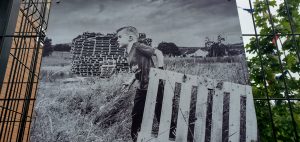
Instead of open conflict, underground militia groups on both sides waged war through bombings, gang violence, and intimidation, with civilians often targeted or caught in the crossfire. The Troubles essentially came to an end with the Good Friday agreement in 1998, but not before over 3500 people lost their lives, including an estimated 1840 civilians. Northern Irish politics and culture are still strongly divided between Unionist and Loyalist groups.
“Belfast,” a memoir of Kenneth Branagh’s early Protestant childhood in Belfast, is a beautiful movie to watch to better understand the beginnings of the conflict.
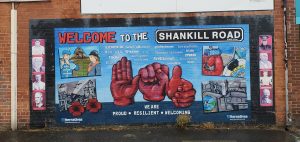
Our walking tour took us past many of the areas that were, and still are, part of that conflict. Shankill Road was a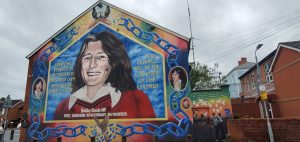 highlight as we got to view many Loyalist Murals and local Street Art. The most photographed mural in the Republican area is the Bobby Sands Mural. Robert Gerard Sands was a member of the Provisional Irish Republican Army who died on a hunger strike while imprisoned at HM Prison Maze in Northern Ireland. The hunger strike was the prisoners’ way of protesting as they wanted to be considered political prisoners as opposed to criminals. It is believed that the primary aim of the hunger strike was to generate international publicity.
highlight as we got to view many Loyalist Murals and local Street Art. The most photographed mural in the Republican area is the Bobby Sands Mural. Robert Gerard Sands was a member of the Provisional Irish Republican Army who died on a hunger strike while imprisoned at HM Prison Maze in Northern Ireland. The hunger strike was the prisoners’ way of protesting as they wanted to be considered political prisoners as opposed to criminals. It is believed that the primary aim of the hunger strike was to generate international publicity.

The Shankill Road area is still surrounded by high fences and the roads are blocked by iron gates. Although it was hoped that the conflicts would lessen over time that has not happened. One area, referred to as the The Peace Gate still closes at night to prevent further conflict between these communities.
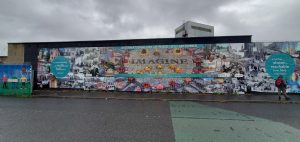
The art was at times compelling and hopeful and at other times a stark reminder of the city’s past. We have found any chance to view the street art of a major city a gritty way of understanding it better.
